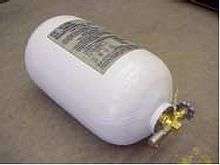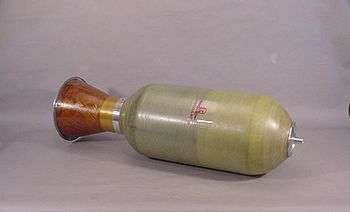Composite overwrapped pressure vessel

A composite overwrapped pressure vessel (COPV) is a vessel consisting of a thin, non-structural liner wrapped with a structural fiber composite, designed to hold a fluid under pressure. The liner provides a barrier between the fluid and the composite, preventing leaks (which can occur through matrix microcracks which do not cause structural failure) and chemical degradation of the structure. In general, a protective shell is applied for protective shielding against impact damage.[1][2] The most commonly used composites are fiber reinforced polymers (FRP),[3] using carbon and kevlar fibers. The primary advantage of a COPV as compared to a similar sized metallic pressure vessel is lower weight, but this may be offset by the increased costs of manufacturing and certification.

Overview
A composite overwrapped pressure vessel (COPV) is a pressure-containing vessel, typically composed of a metallic liner, a composite overwrap, and one or more bosses.[4] They are used in spaceflight due to their high-strength and low weight.[5]
During operation, COPVs expand from their unpressurized state.[6]
Manufacturing
During manufacturing, COPVs undergo a process called autofrettage. The unit is pressurized and the liner is allowed to plastically (permanently) deform. It comes into contact with the overwrap and results in a permanent volume increase. One reason to autofrettage a vessel is to verify the volume increase across pressure vessels in a product line remain within family. Out-of-family data could indicate possible damage to the vessel.[5][7]
Testing
Various tests and inspections are performed on COPVs, including burst test, stress-rupture lifetime, and nondestructive evaluation.[8][9]
Aging
Three main components affect a COPVs strength due to aging: cycle fatigue, age life of the overwrap, and stress rupture life.[4]
See also
References
- ↑ Protective shells for composite overwrapped pressure vessels
- ↑ Metal-Lined Composite-Overwrapped Pressure Vessel
- ↑ A STRUCTURAL HEALTH MONITORING SYSTEM FOR COMPOSITE PRESSURE VESSELS
- 1 2 Russel, Rick. "Composite Overwrapped Pressure Vessels (COPV) Stress Rupture Test. Part 2" (PDF). NASA. Retrieved May 25, 2018.
- 1 2 Kezirian, Michael T. "Composite Overwrapped Pressure Vessels (COPV): Flight Rationale for the Space Shuttle Program" (PDF). AIAA. Retrieved May 24, 2018.
- ↑ Tam, Walter H. "DESIGN AND MANUFACTURE OF A COMPOSITE OVERWRAPPED PRESSURANT TANK ASSEMBLY" (PDF). AIAA. Retrieved May 24, 2018 – via Orbital ATK.
- ↑ Pat B. McLaughlan; Scott C. Forth; Lorie R. Grimes-Ledesma (March 2011). "Composite Overwrapped Pressure Vessels, A Primer" (PDF). NASA. Archived from the original (PDF) on 2015-04-21.
- ↑ Vessel Testing Archived 2008-09-05 at the Wayback Machine.
- ↑ Stress-rupture lifetime testing